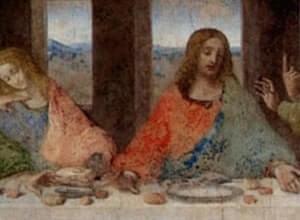The Last Supper Restorations
In 1977, after much study and research, a large and delicate restoration project began. An operation destined to last more than twenty years, and to mobilize scientists, art critics and restorers from all over the world. The surface of the Cenacle was now everywhere peeling and damaged; dust had slipped into millions of microscopic interstices, retaining the humidity of the walls, and thus creating the conditions for the gradual and inexorable disappearance of the painting.
In the cleaning work it was realized that the Cenacle had been partially smeared with wax to be prepared for detachment: a detachment that was never carried out. The poultice of glues, resins, dust, solvents and paints, superimposed over the centuries in an uneven way, had considerably worsened the conditions, already very delicate in themselves, of the pictorial film, by now delivering at the end of the seventies a Last Supper that seemed irreparably compromise. Only a meticulous and rigorous restoration work, supported by surveys and in-depth technological examinations, has made it possible to return to humanity one of the most troubled masterpieces of the history of art.
Among the many unexpected discoveries, the hole of a nail was found in the head of Christ: here Leonardo had hung the threads to draw the course of the whole perspective (vanishing point). The feet of the apostles under the table have also been rediscovered, but not those of Christ: this part was in fact destroyed in the 17th century by the opening of a door that was used by the friars to connect the refectory with the kitchen.
Among the most deteriorated and irrecoverable details is the lower part of Giovanni's face where, as the restorer Pinin Brambilla writes, the nostrils and mouth were now "reduced to small dark strokes". Even the ceiling of the perspective box that we see today is not the original painted by Leonardo but the result of a total eighteenth-century reconstruction which, according to the restorer, "does not respect Leonardo's taste and rhythm". Traces of the original remain only in a thin band on the right, which highlights how the drawers were originally wider, deeper and characterized by moldings with thin red and lacunar bands with a blue-blue background.
The work was declared a World Heritage Site by UNESCO in 1980, and together with it the church and the neighboring Dominican convent are also protected (the reason for the appointment of the two buildings explicitly mentions the painting).
The restoration was completed in 1999.
What does think the people who bought tickets with us
Everything Ok!
Sara M.
Great customer service. Everything was perfect!Cenacolo.it thanks for the excellent service and fast. We are very satisfied.
Michele V.Choose your tour was a most great choice: accuracy, punctuality, good guide. Very good experience.
Patrizio P.I finally managed to visit the Last Supper. Thank you!!
Yana V.
Why buy tickets on cenacolo.it?
Skip the line
The unobtainable tickets to visit the Last Supper.
Voucher on smartphone
You can use the voucher from your smartphone.
Audio guides and video guides
Book your audio guide together with your tickets
Safe shopping
All transactions take place on super secure secure gateways.



